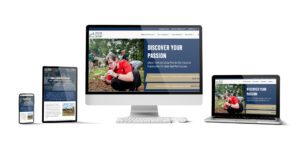A responsive website can make or break your business. Surveys found that 42% of consumers decide whether to remain on a website within 10 seconds of arriving. Plus, even those who do stay may leave if they find the experience frustrating. For instance, sixty percent of e-commerce site shoppers admitted to abandoning items they wanted to purchase because of a poor website experience.
What is one essential ingredient in customer-centric website — responsive web design.
What Does Responsive Web Design Do for My Site?
Responsive web design ensures your website performs effectively across devices, environments, or other factors affecting the user experience. In other words, no matter where your user looks at your website — whether on their computer, their tablet, or their mobile phone or in browsers like Google Chrome, Firefox, or Duck Duck Go — their experience is great.
Responsiveness is vital for businesses because half of all internet users access the internet via mobile devices and, contrary to popular assumption, a site designed to work with browsers like Chrome and Safari will not necessarily function fully on a mobile browser. What could happen if a website is not responsive?
- Site media doesn’t load
- Page text doesn’t resize and is unreadable
- Small or unresponsive navigation buttons
- The site loads slowly or takes up too much memory when the user connects with mobile data
- Applications like shopping carts and payment processing don’t function.
Responsive websites address all these potential issues, allowing users access to a fully functional site regardless of whether they use a laptop, desktop, smartphone, or tablet.
How to Create a Responsive Website
Due to the diverse range of devices used by today’s consumers, you need to choose a web design professional carefully when creating a responsive site. You should only work with developers or web agencies that offer mobile-friendly designs.
To create an excellent user experience that isn’t device-specific, consider the following factors. Some are basic, but others require more technical expertise.
Content Choices Are Vital
If the user has a smaller screen, like a smartphone, they need to be able to see vital information first. The design should prioritize necessary elements and avoid crowding them out with large banners, images, or navigation bars.
Easy Navigation Is Essential
You want to avoid small navigation bars that are hard for mobile users to tap. Users may not have access to the home screen or back buttons that they rely on when using desktop browsers.
Media Optimization Is Crucial for Usability
Design elements like images, logos, or headers that eat up lots of memory can slow down loading times. Professional developers can reduce or compress files to optimize the site for all users, regardless of their device.
Web Caching Can Improve Performance
Web caching involves saving the site content so the version loads instantly when the user navigates back to it on subsequent visits. This feature works on sites that don’t update frequently, and it offers almost instant loading on any type of device or connection.
Other tools, such as a third-party content delivery network (CDN) or Google’s Accelerated Mobile Pages (AMP) plug-in, can also help reduce loading times and improve user experience.
The Importance of CSS in Responsive Web Design
The above tips can help improve your site’s responsiveness, but you need someone with technical expertise to ensure your site is fully responsive and optimized.
Developers use cascading style sheets (CSS), which is a front-end web design language that controls the layout and appearance of your site. Web designers or developers will use different CSS techniques to ensure your pages resize appropriately.
- CSS coders can use ratios to ensure that the layout sizes up or down proportionally. This feature helps ensure a uniform layout regardless of device.
- Developers can insert media queries, which use data about screen size to tell the browser which version of a site to load. This strategy will load a version of the site that is optimized for a vertical layout when the user accesses the site on a mobile device. Media queries can also adjust font and banner sizes so users can read them more easily on small screens.
- Developers know which plug-ins and applications will improve your site’s responsiveness. They can help you balance features, load times, and responsiveness so that your site has the necessary functionality.
You need to ensure all these elements work together to ensure responsiveness on every device type.
Why Partner with a Professional on Website Responsiveness?
Besides technical knowledge, quality service providers have proven frameworks for testing, debugging, and otherwise perfecting sites.
Engenius offers testing on every design project. This phase of any web development project allows the design team to test site responsiveness. It ensures that all the different elements work together seamlessly, producing the desired result whether the user visits your site with a laptop, desktop, iPad, or mobile phone.
Start the Conversation
Interested in learning more about how we can help support your website?





